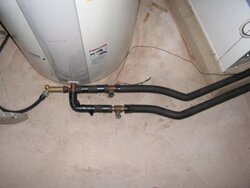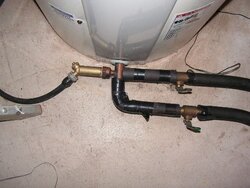I'm thinking more about how to go 100% oil free. Currently we are down to about 180-200 gallons/year after putting in solar HW to shut down our boiler about 8 months per year, and using wood heat as much as possible to keep it off in shoulder periods and minimize use in winter.
The sad part of this, however, is that much of that 200 gallons is standby loss - I estimate at least 0.5 gallons/day, or about 60 gallons in that 4 month winter stretch when the boiler is on. This really aggrevates me in that a relatively low percentage of this expensive oil I buy ever makes it into my house as heat. But it also suggests that I could go with a low level of supplemental heating system even using electric sources and eliminate this altogether, maybe saving money in the process.
I've been thinking about domestic water heat pumps as one possible solution, coupled to radiant tubing on our first floor (not installed, but easy to do and something I'm looking at anyway for better heating efficiency) and part of our second floor (tubing installed following opening ceiling for water leak). Two BRs would be kept at 50 on their own baseboard zone with relatively low temperature water.
There is a nicely documented study from CT where these heat pump systems seem to achieve real-world COP of around 1.8:
http://www.cee1.org/eval/db_pdf/277.pdf
We have an unconditioned, large, and deep basement - only about 1 foot above grade. I suspect that even with one of these systems running, we'd be unlikley to change the basement temperature much beyond ground temperature, so we should have no trouble getting good performance - consistent ambient temperature.
So if I work through this a bit, I could say that while I'm buying 200 gallons of oil a year, I'm really only getting about half that into my house as heat when accounting for combined standby and combustion efficiency losses. This would suggest that I need about (100 gallons) (138,000 BTU/gallon) divided by (4 months)(24 hours/day)(30 days) = 4800 BTU/hr on average for the 4 winter months that I run my boiler to supplement my wood heat. In reality, I know this will spike and drop over time, but I'm assuming that I would use a hydronic storage system to help balance this load, and would be looking at a heat source with a higher rating.
Then the question is would any of this be cost-effective?
My baseline case is just buy 200 gallons of oil. Currently, that oil would run $800/year if I'm lucky, plus I need to maintain my entire oil boiler system which adds a lot of cost.
If I purchased equivalent of 100 gallons of oil with regular electric resistance heaters (i.e. a standard water heater) at $0.15/kwH, I'd spend about $606/year for the energy assuming 100% efficiency, and probably get about the same heat into my home as the 200 gallons of oil. This would have next to no maintenance or complexity. In theory it could even be done with cheap space heaters.
If I was able to realize COP of 1.8 with a heat pump system, I think this means I could drop the price to $337/year. Probably more risk of unplanned maintenance/failure expenses, but probably still less than oil furnace. System cost is around $2000 for a 12,500 BTU system, so about 13-14% return on investment compared to a straight resistance heater.
Anyone want to poke holes in this line of thinking or offer their thoughts?
The other options I haven't sized include adding some high efficiency vacuum tube solar arrays and relying on existing electric resistance heater as backup when those don't do the job, and/or doing a water heat exchange loop behind my woodstove, integrating it into my solar control system as a second solar array that would take heat when stove is hot. The problem with the woodstove heating is that I'm not sure I can move that much more wood through it in the winter without burning faster/less efficiently, but I'd have to be burning at least 25% more wood to generate the required extra BTUs to supply water/radiant heating.
-Colin
The sad part of this, however, is that much of that 200 gallons is standby loss - I estimate at least 0.5 gallons/day, or about 60 gallons in that 4 month winter stretch when the boiler is on. This really aggrevates me in that a relatively low percentage of this expensive oil I buy ever makes it into my house as heat. But it also suggests that I could go with a low level of supplemental heating system even using electric sources and eliminate this altogether, maybe saving money in the process.
I've been thinking about domestic water heat pumps as one possible solution, coupled to radiant tubing on our first floor (not installed, but easy to do and something I'm looking at anyway for better heating efficiency) and part of our second floor (tubing installed following opening ceiling for water leak). Two BRs would be kept at 50 on their own baseboard zone with relatively low temperature water.
There is a nicely documented study from CT where these heat pump systems seem to achieve real-world COP of around 1.8:
http://www.cee1.org/eval/db_pdf/277.pdf
We have an unconditioned, large, and deep basement - only about 1 foot above grade. I suspect that even with one of these systems running, we'd be unlikley to change the basement temperature much beyond ground temperature, so we should have no trouble getting good performance - consistent ambient temperature.
So if I work through this a bit, I could say that while I'm buying 200 gallons of oil a year, I'm really only getting about half that into my house as heat when accounting for combined standby and combustion efficiency losses. This would suggest that I need about (100 gallons) (138,000 BTU/gallon) divided by (4 months)(24 hours/day)(30 days) = 4800 BTU/hr on average for the 4 winter months that I run my boiler to supplement my wood heat. In reality, I know this will spike and drop over time, but I'm assuming that I would use a hydronic storage system to help balance this load, and would be looking at a heat source with a higher rating.
Then the question is would any of this be cost-effective?
My baseline case is just buy 200 gallons of oil. Currently, that oil would run $800/year if I'm lucky, plus I need to maintain my entire oil boiler system which adds a lot of cost.
If I purchased equivalent of 100 gallons of oil with regular electric resistance heaters (i.e. a standard water heater) at $0.15/kwH, I'd spend about $606/year for the energy assuming 100% efficiency, and probably get about the same heat into my home as the 200 gallons of oil. This would have next to no maintenance or complexity. In theory it could even be done with cheap space heaters.
If I was able to realize COP of 1.8 with a heat pump system, I think this means I could drop the price to $337/year. Probably more risk of unplanned maintenance/failure expenses, but probably still less than oil furnace. System cost is around $2000 for a 12,500 BTU system, so about 13-14% return on investment compared to a straight resistance heater.
Anyone want to poke holes in this line of thinking or offer their thoughts?
The other options I haven't sized include adding some high efficiency vacuum tube solar arrays and relying on existing electric resistance heater as backup when those don't do the job, and/or doing a water heat exchange loop behind my woodstove, integrating it into my solar control system as a second solar array that would take heat when stove is hot. The problem with the woodstove heating is that I'm not sure I can move that much more wood through it in the winter without burning faster/less efficiently, but I'd have to be burning at least 25% more wood to generate the required extra BTUs to supply water/radiant heating.
-Colin




